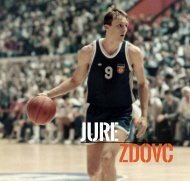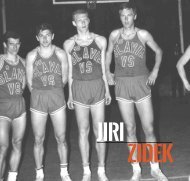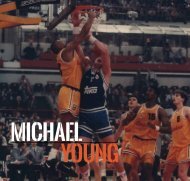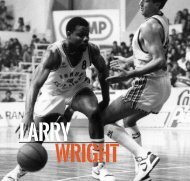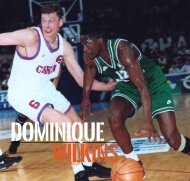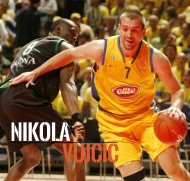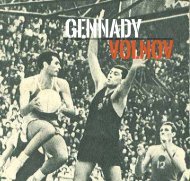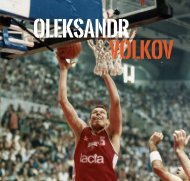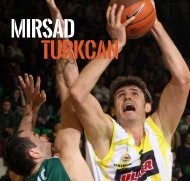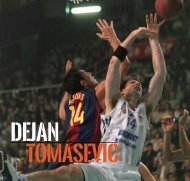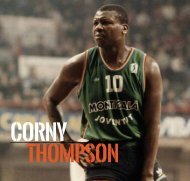101 Greats of European Basketball
You also want an ePaper? Increase the reach of your titles
YUMPU automatically turns print PDFs into web optimized ePapers that Google loves.
The Flying Mexican<br />
In a hypothetical quiz about basketball knowledge,<br />
I doubt there would be a lot <strong>of</strong> correct answers<br />
if the first question were: “Who was the first<br />
non-American player ever drafted by an NBA<br />
team?” I am guessing most people would point<br />
to some <strong>European</strong> legend, but the right answer is<br />
Manuel Raga Navarro <strong>of</strong> Mexico. This unforgettable<br />
player was born on March 14, 1944, in Villa Aldama,<br />
in the Mexican state <strong>of</strong> Tamaulipas. He was chosen<br />
by the Atlanta Hawks with pick number 167 in the<br />
10th round <strong>of</strong> the 1970 draft. In the following round,<br />
the 11th, the first <strong>European</strong> was picked, big man Dino<br />
Meneghin <strong>of</strong> Italy, also by the Atlanta Hawks. But the<br />
first non-American was always Raga.<br />
Marty Blake, the general manager in Atlanta, had<br />
seen that Raga and Meneghin were a great duo at Ignis<br />
Varese, the <strong>European</strong> champion at that time, and both<br />
were capable <strong>of</strong> playing in the NBA. But that was a different<br />
time and teams in the United States didn’t trust players<br />
developed outside <strong>of</strong> the country. Maybe that’s the<br />
reason why the Hawks didn’t want to pay the $35,000 to<br />
free Raga from Varese. The Italian team didn’t even want<br />
to hear about a buyout for Meneghin, who would be its<br />
undisputed star throughout the next decade.<br />
Key part <strong>of</strong> the great Ignis Varese<br />
The name <strong>of</strong> Manuel Raga is found for the first<br />
time in a major competition at the 1963 World Cup in<br />
Rio de Janeiro, Brazil. He was only 19 years old, but<br />
he was already a regular for his national team. Mexico<br />
finished that competition in ninth place, but the young,<br />
1.88-meter guard caught everybody’s attention. He finished<br />
the tourney with 12.3 points per game, with highs<br />
<strong>of</strong> 24 points against Canada and 20 against Uruguay.<br />
Four years later, at the 1967 World Cup in Uruguay, Raga<br />
increased his numbers to 15.6 points and sank Italy<br />
with 31 points. However, the decisive moment in his<br />
career came at the 1968 Olympic Games in his home<br />
country <strong>of</strong> Mexico. The Mexican team, coached by<br />
American Lester Lane, an Olympic champ from Rome<br />
1960, finished fifth thanks to two excellent players: Raga<br />
and Arturo Guerrero. At the same time, Ignis Varese<br />
president Alberto Tedeschi had asked his club’s director,<br />
Giancarlo Gualco, to renew the team. But instead <strong>of</strong><br />
bringing in a well-known American, Gualco brought in a<br />
rather unknown Mexican player. Shortly after his arrival<br />
in Varese, Raga earned the nickname Indian, but shortly<br />
afterward it was changed for two others: The Flying<br />
Mexican and The Phenomenon.<br />
Already in his first season in Italy, in 1968-69, Raga<br />
earned the respect <strong>of</strong> all his colleagues, the admiration<br />
<strong>of</strong> the audience and the kudos <strong>of</strong> the press. Despite<br />
being short, he jumped like nobody else (an estimated<br />
1.1 meters from a standing position). It was said that<br />
he could touch the rim with his elbow. Ignis Varese won<br />
the Italian League with 418 points by Raga, an average<br />
<strong>of</strong> 19.0 over 22 games, enough to finish eighth in the<br />
top scorers’ list <strong>of</strong> the league in which the leader was<br />
ace scorer Radivoj Korac with an average <strong>of</strong> 26 points<br />
even though his Padova team was relegated to the second<br />
division. Raga was also the third-best rebounder <strong>of</strong><br />
the team, with 98 boards, only 5 fewer than Meneghin,<br />
while the leader on the team was Ottorino Flaborea<br />
with 136. Winning the league, Ignis earned the right to<br />
play the EuroLeague, and on April 9, 1970, in Sarajevo’s<br />
new Skenderija Arena (which now bears the name <strong>of</strong><br />
<strong>101</strong> greats <strong>of</strong> european basketball<br />
Manuel Raga<br />
R



